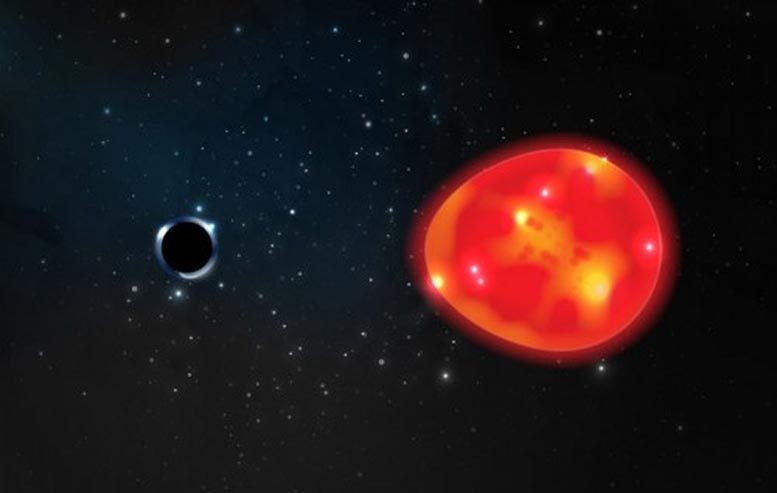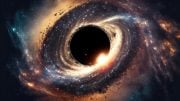
An artist’s illustration of the V723 Monocerotis binary system. Credit: Ohio State illustration by Lauren Fanfer
[Update: Follow-up work argues that V723 Monocerotis does not contain a black hole, but is a mass-transfer binary containing a red giant and a subgiant star that has been stripped of much of its mass.]
Astronomers dub it “The Unicorn,” call it something special.
Scientists have discovered one of the smallest black holes on record – and the closest one to Earth found to date.
Researchers have dubbed it “The Unicorn,” in part because it is, so far, one of a kind, and in part because it was found in the constellation Monoceros – “The Unicorn.” The findings were published on April 21, 2021, in the journal Monthly Notices of the Royal Astronomical Society.
“When we looked at the data, this black hole – the Unicorn – just popped out,” said lead author Tharindu Jayasinghe, a doctoral student in astronomy at The Ohio State University and an Ohio State presidential fellow.
The Unicorn is about three times the mass of our sun – tiny for a black hole. Very few black holes of this mass have been found in the universe. This black hole is 1,500 light years away from Earth, still inside the Milky Way galaxy. And, until Jayasinghe started analyzing it, it was essentially hiding in plain sight.
The black hole appears to be a companion to a red giant star, meaning that the two are connected by gravity. Scientists can’t see the black hole – they are, by definition, dark, not only visually, but to the tools astronomers use to measure light and other wavelengths.
But in this case, they can see the black hole’s companion star. That star had been well-documented by telescope systems including KELT, run out of Ohio State; ASAS, the precursor to ASAS-SN, which is now run out of Ohio State, and TESS, a NASA satellite that searches for planets outside our solar system. Data about it had been widely available but hadn’t yet been analyzed in this way.
When Jayasinghe and the other researchers analyzed that data, they noticed something they couldn’t see appeared to be orbiting the red giant, causing the light from that star to change in intensity and appearance at various points around the orbit.
Something, they realized, was tugging at the red giant and changing its shape. That pulling effect, called a tidal distortion, offers astronomers a signal that something is affecting the star. One option was a black hole, but it would have to be small – less than five times the mass of our sun, falling into a size window that astronomers call the “mass gap.” Only recently have astronomers considered it a possibility that black holes of that mass could exist.
“When you look in a different way, which is what we’re doing, you find different things,” said Kris Stanek, study co-author, astronomy professor at Ohio State and university distinguished scholar. “Tharindu looked at this thing that so many other people had looked at and instead of dismissing the possibility that it could be a black hole, he said, ‘Well, what if it could be a black hole?’”
That tidal disruption is produced by the tidal force of an unseen companion – a black hole.
“Just as the moon’s gravity distorts the Earth’s oceans, causing the seas to bulge toward and away from the moon, producing high tides, so does the black hole distort the star into a football-like shape with one axis longer than the other,” said Todd Thompson, co-author of the study, chair of Ohio State’s astronomy department and university distinguished scholar. “The simplest explanation is that it’s a black hole – and in this case, the simplest explanation is the most likely one.”
The velocity of the red giant, the period of the orbit and the way in which the tidal force distorted the red giant told them the black hole’s mass, leading them to conclude that this black hole was about three solar masses, or three times that of the sun.
For about the last decade, astronomers and astrophysicists wondered whether they weren’t finding these black holes because the systems and approaches they used were not sophisticated enough to find them. Or, they wondered, did they simply not exist?
Then, about 18 months ago, many of the members of this Ohio State research team, led by Thompson, published a scientific article in the journal Science, offering strong evidence that these types of black holes existed. That discovery motivated Jayasinghe and others, both at Ohio State and around the world, to search in earnest for smaller black holes. And that evaluation led them to the Unicorn.
Finding and studying black holes and neutron stars in our galaxy is crucial for scientists studying space, because it tells them about the way stars form and die.
But finding and studying black holes is, almost by definition, difficult: Individual black holes don’t emit the same kind of rays that other objects emit in space. They are, to scientific equipment, electromagnetically silent and dark. Most known black holes were discovered because they interacted with a companion star, which created a lot of X-rays – and those X-rays are visible to astronomers.
In recent years, more large-scale experiments to try and locate smaller black holes have launched, and Thompson said he expects to see more “mass gap” black holes discovered in the future.
“I think the field is pushing toward this, to really map out how many low-mass, how many intermediate-mass and how many high-mass black holes there are, because every time you find one it gives you a clue about which stars collapse, which explode and which are in between,” he said.
Reference: “A unicorn in monoceros: the 3 M⊙ dark companion to the bright, nearby red giant V723 Mon is a non-interacting, mass-gap black hole candidate” by T Jayasinghe, K Z Stanek, Todd A Thompson, C S Kochanek, D M Rowan, P J Vallely, K G Strassmeier, M Weber, J T Hinkle, F-J Hambsch, D V Martin, J L Prieto, T Pessi, D Huber, K Auchettl, L A Lopez, I Ilyin, C Badenes, A W Howard, H Isaacson and S J Murphy, 1 May 2021, Monthly Notices of the Royal Astronomical Society.
DOI: 10.1093/mnras/stab907
Other Ohio State researchers who co-authored this paper include Chris Kochanek, Dominick Rowan, Patrick Vallely, David Martin and Laura Lopez.









The laser beam, the focus of the column of light. Look quick because in a flash if the little boys in blue, with their fat backs sitting in plump chairs can experiment from a place not too far from you, expanding the focus and boom in one second or two, the cancer strikes you down, like the covid crown, an immunodeficiency disease, aids if you recall has been sent upon us all by those who hide behind, or in radio cities music hall the real time surveillance horses of local governors of even more local people who have nothing to do with their their lives but screw with the poor by focusing on their bandwidth of our fine marrows in the halls of our homes spreading music of decay in our children’s way… imagine the the future, very soon, they say. Or do you not see what they do with nuclear energy and the millions they pad their retirement accounts with as they exterminate us each and every day. Hello mayor, are you getting paid stimulated perhaps as you lite the candle of your fire in your plush halls of your home paid for by the lives of the poor?
I want some of what peter’s smoking.
WT actual F?
I don’t think Peter grasps the gravity of the situation.
LMAOOOO
Galaxy of God hates sinners vacuuming on the earth sinners last days Holy Bible say their exact words. Jesus Christ thank my witnessed vision Jesus shaped.
Peter, that was dumb.
@peter irrelevant comment, go home you’re drunk
@richard prove that your god exists, you’re also drunk, go home
The padded room is the 1st door on the right.
What if… okay there are people out there having premonition of the future before it happen in there dream. They are among us and know that society is not ready to accept them. So they write story, scripts, and books. What if the we transform history/our memories into data then transform/transmitt it brain wave pattern that matches our dream wave, and by sending it through the black hole. What if that is the connection between past, present and future. Then out brain wave will recieve it as dream image. Sound crazy…but what if we try and it is true? Then its genius.
Narcotics are not a solution, Peter.
Narwhal
@Peter M Foster
Sir, this is a Wendy’s
😂 the comments
Peter I now know the “M” in your name is for meth…..
Please leave the weird comments somewhere else.
Did anyone catch the red giant’s designation and mass? I do remember an Anton Petrov video on YouTube where he discussed the discovery of a triple star system about 1000 lbs with a blackhole ⚫ in an equal orbit with an inner star while another star orbits the inner pair.
Not lbs, I meant l y s , light years! Dang autocorrect!
Peter, Richard and Brandon seems to consume drugs before (not) reading the article and instead comment on random, incomprehensible or superstitious topics.
The distance between the star and the companion is just ~100 Sun radii (the red giant ~ 20 Sun radii).
There are more of these out there.
“We can very crudely estimate the expected number of similar systems based on the fraction of the thin disk mass from which V723 Mon was selected. … This implies that the Galaxy might contain some 100-1000 similar systems. Since ellipsoidal variability is only possible for a limited range of semimajor axes, it is not surprising that this estimate is larger than the number of mass transfer systems but smaller than estimates of the total number (10^3 to 10^4 ) of noninteracting black hole binaries in the Galaxy based on population synthesis models …”.
Peter, I am the fat man. It is true. You are the bane of our existince yet the crux of it as well. I can ramble and wax philosophical just like you, little man.
It only goes to show that we are the same. Like bugs and fudd, equally ridiculous and outlandish to those who see the truth. And we will end the same when the time comes. My nest egg money will mean nothing when the ash of hellfire settles. If only you could live like I do, as if every day was my last, yolo-ing and hodling, then you would find true happiness. You speak of radio but never listen to it.
My children’s children will rule your children’s children for eternity as is known on this planet. The solution lies in the cosmic soup.
A little dorky, but I just found a satirical news piece on ‘The Unicorn’ if anyone is interested 🙂
https://thenerdstash.com/the-quirky-quark-black-hole-not-too-keen-on-its-new-name/
What we don’t see can totally end us we are just viruses waiting the universal antibody to erase us and move on
It is all what you know.
It is not a good thing or a bad thing, but just so.
It is all perspective/ perception of the light( the force) and these elementary particles of wannabes, in short.
That make hydrogen, the father and mother of the rest of them by most accounts.
That about 100 years ago they discovered that every thing is light, electricity with the electromagnetic field that we call earth, that we call the sun, that we the universe.
That now we are all realizing that it is thought too, but of how, when and of where.
All the different forms of light.
Of all the duality between particles and wave.
Of the Superposition of all quantum states.
That everything is of being.
That what is, has been and will always be.
It is all what you know.
It is not a good thing or a bad thing, but just so.
It is all perspective/ perception of the light( the force) and these elementary particles of wannabes, in short.
That make hydrogen, the father and mother of the rest of them by most accounts.
That about 100 years ago they discovered that every thing is light, electricity within these electromagnetic fields that we call earth, that we call the sun, that we call the universe, that we may call a tree.
That everything is a whole/a hole of a lot of different parts of before and after and all around.
A continuum.
Of not one, but of those before and after and around still happening.
That it might not necessarily all happen all at once.
That now we are all realizing that it is thought too, but of how, when and of where.
All the different forms of light.
Of all the duality between particles and wave.
Of the Superposition of all quantum states.
That everything is of being.
That what is, has been and will always be.
The first law of thermodynamics energy can not be destroyed.
Everything is energy including yourself.
Yall are smoking some seriously good stuff I definitely need to invest can you hit me up with a plug??
ohhh waoo simply not so simple… all were great nd cute for explanning this phenominal phenomina… ur wonderful researches help me allot to add in my knowledge…thank yo geniuses i am so lucky to read ur valuable comments… lavvv u… umaaa ..!!
Peter’s not smoking anything. That’s some ass-kicking hallucinogenic acid he’s on.
So why not use like send out a space probe. Calculate the force it would take to get the probe stuck. Between the unicorn. And it’s neighboring star? Give the probe like a super solar flashlight. And maybe we can use Morse code to potential other Galaxy species? Or just get some neat shots of a black hole eat some light.
Why have I not ever seen a sideways on picture of a black hole ?
“Unicorn” – because naming it “Unicron” would reveal why they became astronomers in the first place.
When I was 12, I thought what if aliens were mutated humans traveling back through time by way of black holes abducting humans for a short time to collect DNA to put the human race back together. My mother swears when she was young she was abducted for a short time and then put back
Hi, I called myself a unicorn a few weeks ago, but I’m not a black hole, so I obviously didn’t know what I was talking about. However, I do sense that I am a mental clone of a future self having come back in time. But I cannot remember the future, only what is revealed to me in a realtime stream of consciousness like I’m reading from a script printed in my DNA. I meet people who claim they can see their futures in detail. Some tell me that to advance in my awareness I should go to the mental hospital or even a drug rehab. This doesn’t make sense to me. Are they just trying to insure I do not go to such a place by using reverse psychology tactics on me?
Why do the whack jobs and conspiracy nuts comment on scientific articles and then spew their garbage? I think that it would be the wrong place to find converts
Wow Peter! Gotta few screws loose do ya!!??